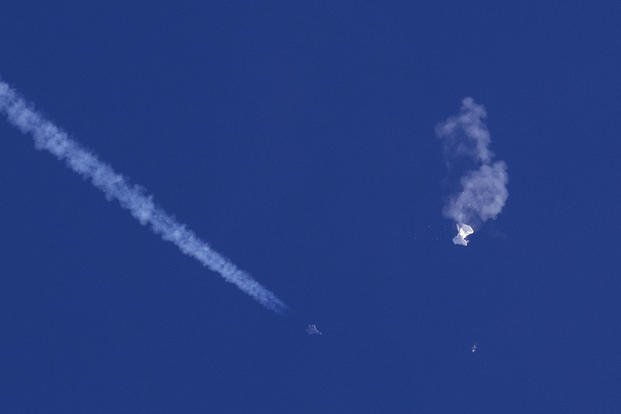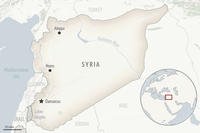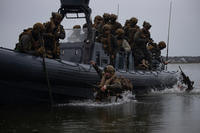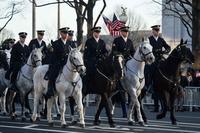The opinions expressed in this op-ed are those of the author and do not necessarily reflect the views of Military.com. If you would like to submit your own commentary, please send your article to opinions@military.com for consideration.
Matthew Brazil is the co-author, with Peter Mattis, of Chinese Communist Espionage, An Intelligence Primer.
In 1976, I spent the summer in Taiwan studying Chinese, living with the family of an officer in Taiwan’s defense forces. The colonel commanded a political warfare battalion on Quemoy, one of the Nationalist-held island redoubts just 10 kilometers from mainland China. His principal weapon: balloons. Their payload: anti-communist propaganda leaflets.
The colonel remained mum about the details, and politely rebuffed my requests to travel along with him to the island (known locally as Jinmen) for a visit. All this came back to me earlier this month, when a news photographer in Billings, Montana captured the image of a mysterious high-altitude object, which was soon tagged as a Chinese spy balloon. “Hysteria,” as Beijing called the furor (and not so wrongly) ensued.
And there was befuddlement. Why, people asked, did China float balloons over the U.S. when it (like other major powers) has hundreds of spy satellites in Near Earth Orbit? As it turned out, the answer was available in plenty of open source information by outlets ranging from the Union of Concerned Scientists to China itself.
How High?
First, the altitude of the “Chinese spy balloon” was estimated as 60,000 feet (18.3 kilometers). At such a height it was flying ten times closer than the lowest Earth-orbiting satellites. A surveillance platform on a balloon at 18 km can “see” more and intercept faint signals that would be reflected back to earth by the top layer of the atmosphere between it and the edge of space.
There was no small irony, meanwhile, in Beijing’s outrage that we shot down its balloon once it cleared the continental U.S. Back in the day China regularly shot down even manned U.S. and Taiwanese overflights (and probably tried without success many other times). But balloons were a constant annoyance.
In May, 1974, for example, an angry Premier Zhou Enlai ordered an alleged American spy balloon to be blasted out of the sky, according to an article by the retired U.S. diplomat David Cowhig, who referenced a report on the Chinese news site Baidu. According to these sources the balloon had drifted across China from Xinjiang in the west almost all the way across the mainland to its east coast before being downed by a J-6 fighter in Hebei province, not far from Beijing.
Zhou’s aggravation may have stemmed from previous American and Taiwan aerial incursions.
In the 1960s American U-2 pilots overflew China’s far west to spy on China’s nuclear program, apparently without casualties. Taiwan’s pilots had less luck: Five U-2s flown by pilots from Taiwan were shot down between 1962 and 1967, years after Francis Gary Powers was downed over the Soviet Union. In an eerie parallel with this month’s scuttling of a meeting between Secretary of State Antony Blinken and Chinese Foreign Minister Wang Yi, that May 1960 calamity derailed a planned summit meeting between President Eisenhower and Soviet leader Nikita Khrushchev.
Still Flying
Washington monitors China with every tool at its disposal—including, today, it seems, balloons, according to a definitive 2021 article in Popular Mechanics. Code names for the hot air recon ops, according to author and aerospace expert David Hambling: COLD STAR (COvert Long Dwell STratospheric ARchitecture), CICADA (Close-in Covert Autonomous Disposable Aircraft) and TRIPPWIRE (Tactical Responsive Intelligence, Surveillance, and Reconnaissance Platforms and Payloads Watching Isolated Remote Environments).
An axiom of espionage services the world over is to do whatever works, without getting caught, to accomplish the mission, whether via dispatching agents to eyeball ground facilities, sending divers into the ocean to attach eavesdropping devices to undersea cables, or flying specially equipped aircraft and sailing ships off the coast of an adversary to intercept its radio and other signals.
And vice-versa. According to articles in the New York Times on February 9 and 13, Beijing’s balloon program is extensive and probably run by China’s Strategic Support Force—with some unintended technical help from firms in the West, according to the Defense One newsletter. Nor is China shy about it. Beijing’s advances in the development of spy balloons have even been touted on Chinese domestic television, as highlighted by exile dissident Fengsuo Zhou on Twitter.
People didn’t make such a fuss about it until this month, when that big white orb, dangling a surveillance apparatus the size of three school buses (we were told again and again) loitered over Montana’s missile bases. Previous Chinese balloon incursions, during the Trump administration, didn’t earn a peep, or allegedly were missed.
Back to the Future
There was a time when “duck-and-cover” school drills, and nuclear bomb shelters, were commonplace. They were just part of the nuclear age social landscape. But “balloongate” was unnerving for millions—despite the craft posing no danger to Americans. Or as former CIA and NSA director and retired Air Force Gen. Michael Hayden put it to SpyTalk in the opening hours of the furor, “Really, it’s not a big deal. We can neutralize it so I don’t think it’s a danger either.”
We may have to get used to them, like so many other features of the bygone Cold War, however unsettling.
During the 1960s, Navy P-3 Orion aircraft from California’s Moffett Field flew west every morning at recess over my grade school in nearby Campbell, in the San Francisco Bay area. Even as children, we were told over the dinner table and in the classroom that they were heading for the ocean to observe Russian submarines and “trawlers” that were actually spy ships.
We also learned that, a decade before, a kid our age had found a hollow nickel from his newspaper route with microfilm inside, leading years later to the apprehension of a deep-cover Soviet agent (an incident dramatized in the film Bridge of Spies).
Yet somehow the sky did not fall and there was less partisan finger pointing accompanying every revelation about espionage against the U.S. Our society was, in short, much more mature about these things. And not to put too fine a point on it, that society won the Cold War.
Whether or not we are entering another period with threads reaching back to that time, we would benefit from a bit more sobriety in our public debate about espionage and counterespionage. Since our political leaders seem to have trouble disciplining themselves to stick to facts and find solutions, a better-informed voting public—better educated without hyperbole about foreign espionage threats—may offer a remedy to alleviate, if not solve, our current condition.
We could start with a public discussion about how, as the late CIA operative and diplomat James Lilley used to say, “everybody spies.” And how sober public awareness, with enough trained people to do solid counterespionage work for government and for our industries that Beijing so assiduously targets, catches more spies than does the heated rhetoric on Capitol Hill.
Or as Taylor Swift puts it, “You need to calm down.”















